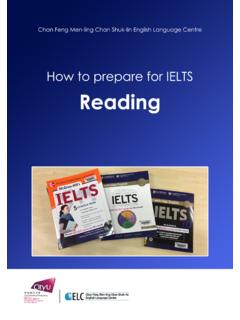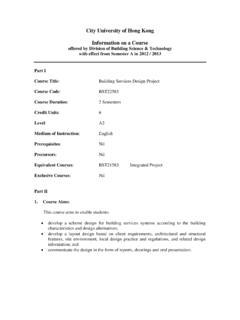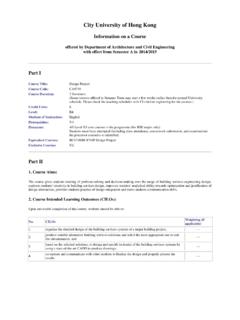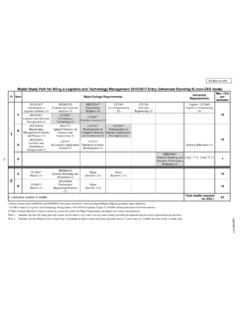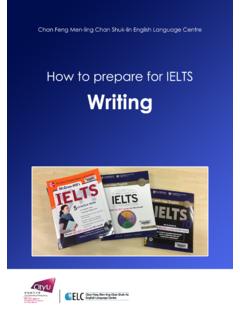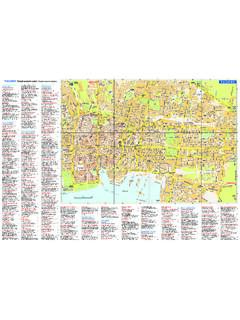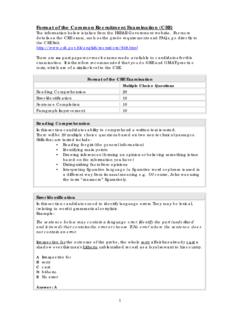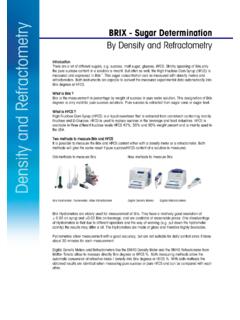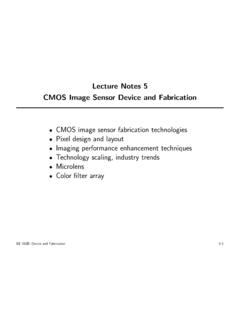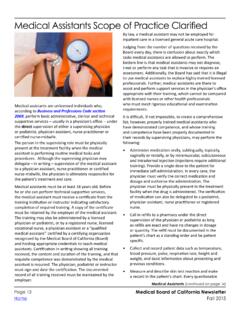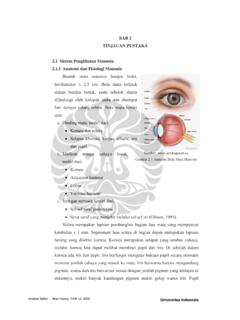Transcription of CHAPTER 5: Lithography
1 CHAPTER 5 1 1 CHAPTER 5: Lithography Lithography is the process of transferring patterns of geometric shapes in a mask to a thin layer of radiation-sensitive material (called resist) covering the surface of a semiconductor wafer. Figure illustrates schematically the lithographic process employed in IC fabrication. As shown in Figure (b), the radiation is transmitted through the clear parts of the mask and makes the exposed photoresist insoluble in the developer solution, thereby enabling the direct transfer of the mask pattern onto the wafer. After the patterns are defined, an etching process is employed to selectively remove masked portions of the underlying layer.
2 The performance of a lithographic exposure is determined by three parameters: resolution, registration, and throughput. Resolution is defined to be the minimum feature dimension that can be transferred with high fidelity to a resist film on a semiconductor wafer. Registration is a measure of how accurately patterns on successive masks can be aligned or overlaid with respect to previously defined patterns on the same wafer. Throughput is the number of wafers that can be exposed per hour for a given mask level and is thus a measure of the efficiency of the lithographic process. Figure : (a) Lithographic process flow chart. (b) Optical replication process. CHAPTER 5 2 2 Clean Room An IC fabrication facility requires a clean room, particularly in Lithography areas.
3 Dust particles settling on semiconductor wafers and lithographic masks can cause defects in the devices. As illustrated in Figure , airborne particles adhering to the surface of a photomask behave as opaque patterns that can be subsequently transferred to the circuit patterns, thus leading to deleterious ramifications. For example, particle 1 in Figure may result in the formation of a pinhole in the underlying layer. Particle 2 may cause a constriction of current flow in the metal runner, whereas particle 3 may lead to a short circuit between the two conducting regions and render the circuit useless. Figure : Various ways in which dust particles can interfere with photomask patterns.
4 In a clean room, the total number of dust particles per unit volume must be tightly controlled along with other parameters such as temperature, humidity, pressure, and so on. A class X clean room is usually defined to be one that has a dust count of X particles (diameters of m or larger) per cubic foot. As shown in Figure , the particle count is higher as the particle size becomes smaller. For modern lithographic processes, a class 10 or better clean room is required. CHAPTER 5 3 3 Figure : Particle-size distribution curve. For more detailed discussions on cleanroom technology and design, please peruse CHAPTER 1 of ULSI Technology. CHAPTER 5 4 4 Example If a 125-mm diameter wafer is exposed to for 1 minute to an air stream under a laminar-flow condition at 30 m/min, how many dust particles will land on the wafer in a class 10 clean room?
5 Solution For a class 10 clean room, there are 350 particles ( m or larger) per cubic meter. The air volume that goes over the wafer in 1 min is: (30 m/min) x x 1 min = m3 The number of dust particles ( m or larger) contained in the air volume is 350 x = 128 particles Therefore, if there are 200 IC chips on the wafer, the particle count amounts to one particle on each of 64% of the chips. Fortunately, only a fraction of the particles that land adhere to the wafer surface, and of those only a fraction are at a circuit location critical enough to cause a failure. However, the calculation indicates the importance of the clean room. CHAPTER 5 5 5 Optical Lithography The vast majority of lithographic equipment for IC fabrication is optical equipment using ultraviolet light ( m to m) or deep ultraviolet light.
6 There are basically two optical exposure methods: shadow printing and projection printing. In shadow printing, the mask and wafer may be in direct contact, as in contact printing, or in close proximity, as in proximity printing (Figure ). Contact printing yields very high resolution (~ 1 m), but suffers from major drawback caused by dust particles or silicon specks accidentally embedded into the mask, thereby causing permanent damage to the mask and defects in the wafers. Proximity printing is not as prone to particle damage. However, the small gap between the mask and wafer (typically 10 m to 50 m) introduces optical diffraction at the feature edges on the photomasks and the resolution is typically degraded to the 2 to 5 m regime.
7 Figure : (a) Contact printing. (b) Proximity printing. The minimum line-width that can be printed, lm, in shadow printing is roughly given by: lm = ( g)1/2 (Equation ) CHAPTER 5 6 6 where is the wavelength of the exposure radiation and g is the gap between the mask and the wafer and includes the thickness of the resist. For typical values of (~ m) and g (~ 50 m), lm is on the order of m. Equation imparts that the minimum linewidth can be improved by reducing the wavelength (that is, going to deep UV spectral region) or the gap g. In order to circumvent problems associated with shadow printing, projection printing exposure tools have been developed to project an image of the mask patterns onto a resist-coated wafer many centimeters away from the mask.
8 The small image area is scanned or stepped over the wafer to cover the entire surface. Figure depicts the various ways to project and scan the image. The resolution of a projection system is given by: lm = / NA (Equation ) where is the wavelength of the exposure radiation and NA is the numerical aperture given by: NA = nsin (Equation ) where n denotes the refraction index of the imaging medium (n = 1 in air) and is the half angle of the cone of light converging to a point image at the wafer as shown in Figure The depth of focus, z, can be expressed as: z = lm/2tan lm/2sin = n /[2(NA)2] (Equation ) Resolution can be enhanced by reducing and this explains the trend towards shorter wavelength in optical Lithography .
9 Typically, scanning projection systems are capable of about 1 m resolution, while step-and-repeat projection systems can accomplish deep sub-micrometer spatial resolution demanded by modern integrated circuits, especially when coupled with deep UV radiation sources. CHAPTER 5 7 7 Figure : Image transfer techniques for projection printing. (a) Annular-field wafer scan. (b) Small-field raster scan. (c) Reduction step-and-repeat. (d) 1:1 step and repeat. Figure : Simple image system. CHAPTER 5 8 8 Masks For VLSI (> 105 components/chip) and ULSI (> 107 components / chip), the patterns are generated using computer-aided design (CAD) systems. The digital CAD output drives a pattern generator that transfers the patterns directly to the photosensitive masks.
10 Masks are typically made from glass covered with hard-surface materials such as chromium or iron oxide. The number of mask defects has a profound effect on the final IC yield, which is defined as the ratio of good chips per wafer to the total number of chips per wafer. As a first-order approximation, Y exp{-DA} (Equation ) where Y is the yield, D is the average number of "fatal" defects per unit area, and A is the area of an IC chip. If D remains the same for all mask levels, N, then Y exp{-NDA} (Equation ) Figure shows the mask-limited yield for a 10-level lithographic process as a function of chip size for various values of defect densities.

